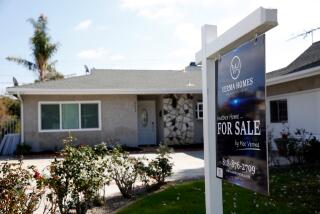Game Plan for Housing in ‘86: No Super Year
- Share via
This being Super Bowl Sunday--a self-proclaimed national holiday--it might be fitting to consider the economic game plan for real estate and housing for each half of 1986.
For starters, no one really expects it to be a super year. There is widespread agreement by almost all the seers and economists that the first six months will be a continuation of a placid market, a comfortable trough with relatively good interest rates and stable inflation.
A few optimists see the possibility of rates for conventional mortgages, currently hovering around 10.8% nationally, crossing over into single-digit territory. That would be super. They cite low inflation, dropping crude-oil prices and the falling value of the dollar as vital considerations.
Also, if the economic recovery continues its languid pace, that will be an added weight pushing rates downward.
Interest rates being what they are--unpredictable--the surer bet is that the first half will remain as good a time as any to borrow money. The housing industry has scars from here to there from coping with the various cyclical periods it has weathered and the buy-and-borrow window most likely will remain “open” until summer.
For the second half, there is strong agreement that any movement of interest rates will be upward but that fixed interest rates will remain under 12%.
State and national industry organizations too go along with the forecast of a fairly predictable first half and a questionable and less favorable second half.
As defined by the National Assn. of Home Builders, the metropolitan marketing area of Los Angeles-Anaheim-Riverside will top the nation in housing starts when final 1985 figures are compiled, retaining that national ranking for the overlapping communities within Los Angeles and Orange counties and portions of the Inland Empire (Riverside and San Bernardino counties). The increase in starts from 1984 to 1985 should be 10.8%, the NAHB reported.
That same market area in 1986, according to NAHB forecasters, will show a slight drop in starts, from the estimated 108,000 housing units started last year, to 103,000 this year.
In the resale market, California recorded 406,000 single-family transactions last year, up a modest 6.3% from 1984. Statewide, the California Assn. of Realtors is anticipating that 395,000 resales will take place this year, while nationwide, about 3.1 million homes will be resold.
In the world of fine print and commercials, there is the constant warning phrase “some restrictions apply.” Economic forecasting also presents some barriers in predicting what a new year will bring, particularly this election year.
Howard Craven, senior vice president and economist for Union Bank, writing in the current issue of Lawyers Title News, is concerned with three “ifs.”
“The momentum with which the influence of current economic conditions carries over into 1986;
“The outcome of major policy decisions which presently are pending and;
“Developments that are presently not in view at all or are highly problematical.”
Those “developments” could include the outbreak of a war or a major peace arrangement, civil insurrection, severe bankruptcies or abrogations of debt by major debtors. Any of his three principal concerns could alter and influence this year’s economic performance, for better or for worse.
Meanwhile, back at Super Bowl XX in New Orleans. . . .
More to Read
Inside the business of entertainment
The Wide Shot brings you news, analysis and insights on everything from streaming wars to production — and what it all means for the future.
You may occasionally receive promotional content from the Los Angeles Times.










